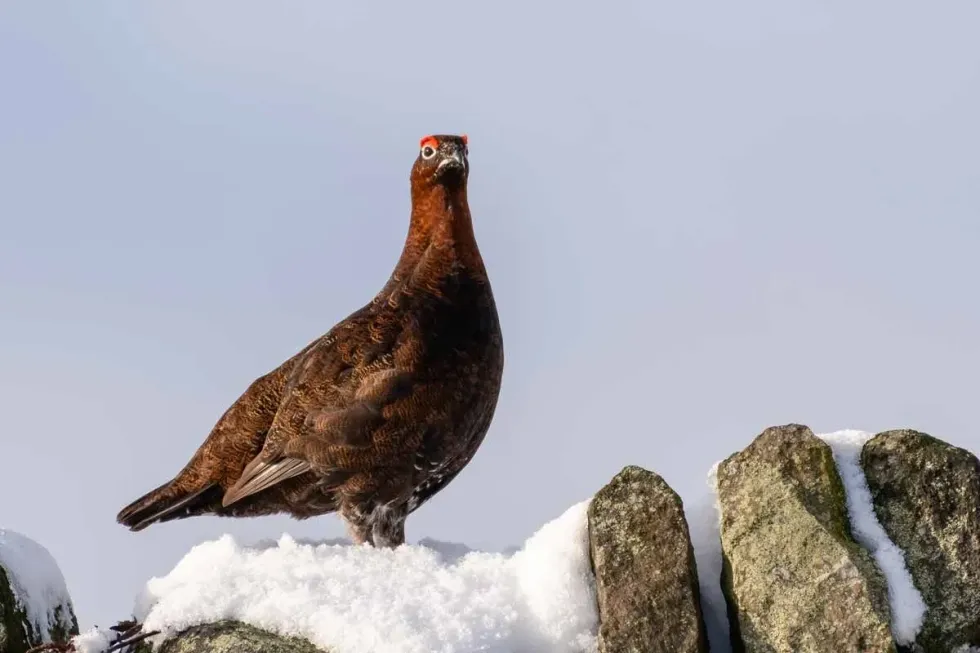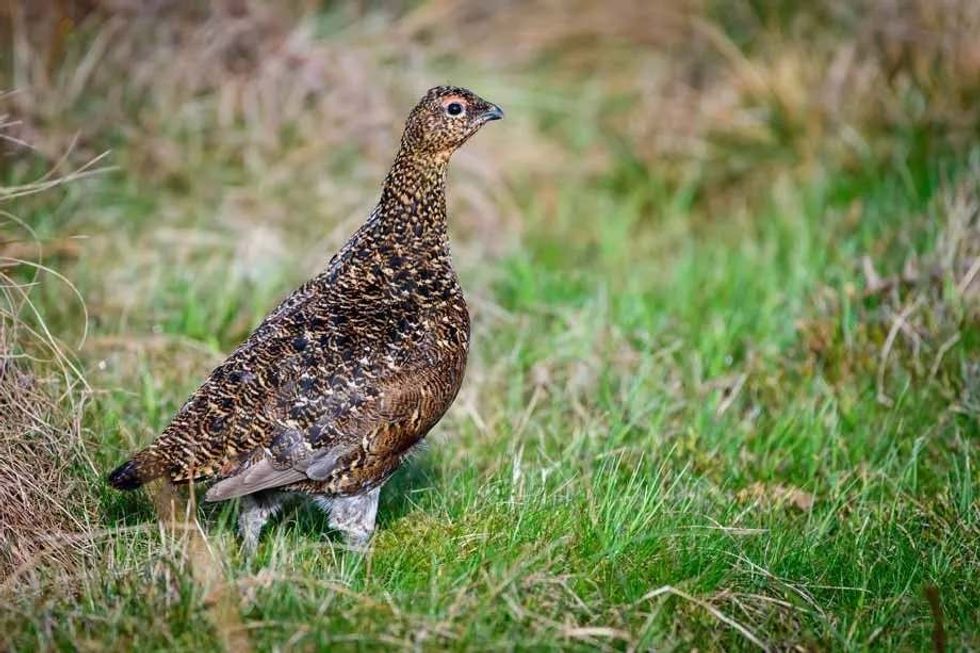Have you ever heard of a bird with inflated air sacs and a fluffy appearance? Well, for some of you this will be an entirely new species but if you are a North American, then you must be familiar with this species known as greater sage grouse.
Greater sage grouse, centrocercus urophasianus, are fluffy and giant birds with inflatable air sacs! When it comes to diet, they follow an omnivore diet. The diet of greater sage grouse comprises primarily of sagebrush and some small insects.
The derive their name from their habitat in sagebrush plains and preference of eating sagebrush as a part of their diet. Their chicken like appearance is unique to the birds from the sagebrush steppe.
These sagebrushbirds are facing the threat of extinction and have been categorized under the near threatened category by the IUCN. Efforts for the conservation of these birds are being organized in various regions.
The historic range of greater sage grouse expanded over 13 different states in the US. Isn't it interesting?
Well, this species is full of such interesting facts, and this article will provide you with all that is relevant and exciting to know about a greater sage grouse. If you want to know more about birds, you may also check out Guam rail facts and common kingfisher facts.
Greater Sage-grouse Interesting Facts
What type of animal is a greater sage-grouse?
A greater sage-grouse (centrocercus urophasianus) is a bird of the Phasianidae family. With its fluffy and cute appearance, these sagebrush birds can impress anyone as they look quite adorable. They are also comparatively taller and bigger than Anna’s humming bird and are extremely famous as a North American birds.
What class of animal does a greater sage-grouse belong to?
A greater sage-grouse belongs to the Aves class of animals that are found in sagebrush plains spread across various regions of North America.
How many greater sage-grouse are there in the world?
The population of greater sage grouse is said to be decreasing. At present, there are around 2,00,000 - 5,00,000 greater sage in the world.
The population of this species has declined heavily as long time back there were around 16 million individuals of this species and now the figure has reduced drastically, primarily due to habitat loss in sagebrush steppe.
Where does a greater sage-grouse live?
The greater sage-grouse is found only on the sagebrush steppe region in North America. The areas where they are commonly found are the western United States, southern Alberta, South Dakota, Saskatchewan, and Canada.
What is a greater sage-grouse's habitat?
The greater sage-grouse makes its habitat in several types of sagebrush during different seasons. Their nest can be found in an area that is densely covered with large sagebrushes (Artemisia tridentata).
They can also make their habitat in grassy areas and as well as in rabbitbrush, greasewood. Leks prefer to live in areas like dry land, grassy spaces and broad ridgetops. Sometimes, they may be seen residing in a recently burned place as it provides a more clear area to the greater sage grouse.
Who do greater sage-grouse live with?
Mostly, all greater sage-grouses live in big groups, especially in the winter season. Seeing these birds living in large groups in sagebrush plains is common.
How long does a greater sage-grouse live?
The average lifespan of a greater sage grouse is 1-1.5 years.
How do they reproduce?
Each spring, male greater sage-grouses get together on leks to dance and compete with each other. The selective females pick their favorite mate, which is generally the dominant male.
The greater sage grouse mating process starts after this selection. In order to lay eggs, the females build nests that are bowl-shaped and scoured into the soil, and edged with leaves, grasses, and small twigs.
Females build their nest by plucking their breast feathers and lining them with the nest. The interior of the nest is about 7-9 in wide and 3–5 in deep.
Females lay around 6-8 eggs, and these eggs are almost hidden in a deep nest concealed by sagebrush. Chicks are light at birth and are ready to run after their mothers.
What is their conservation status?
The conservation status of the greater sage grouse is near threatened. The population of this species has declined heavily as a long time back there were around 16 million individuals of this species and now the figure has reduced drastically.
The recent estimated population of the greater sage grouse is 2,00,000-5,00,000 due to destruction of their habitat in sagebrush steppe.
Greater Sage-grouse Fun Facts
What do greater sage-grouse look like?
The greater sage-grouse is a fluffy and mottled grey-brown birds with a black belly. The head and throat of the male are black, the breast is fluffy, white ruffed, and on the displays surrounds a pair of inflatable, yellow air sacs.
The females have dark cheek patches highlighted by the white markings at the back of their eyes. The chicken-like appearance sets them apart from other birds in the region.

How cute are they?
Yes, greater sage grouses are indeed cute. This brown and white feathered bird is fluffy and its tiny beak gives it a cute look.
How do they communicate?
In order to communicate, the greater sage grouse make calls. Ruffed grouse are mostly silent, but they do make sounds. The call made by females includes a hiss-like alarming sound. They silent their chicks with a rebuking call and release a low, sound when they need to call their brood.
How big is a greater sage-grouse?
Greater sage grouses are 30 in long and 3 ft tall, which means that they are almost 10 times bigger than Anna's hummingbird.
How fast can a greater sage-grouse fly?
Greater sage-grouse are strong, fast fliers, but their stamina is not a very good. Despite their heavy bodies, they can fly pretty fast. Greater sage grouse are strong fliers with a recorded top speed of almost 50 mph and they are capable of flying up to 6 miles for one flight.
However, the sage grouse mostly prefer to walk. They face a slight difficulty in running as they have shorter legs. Hiding and flying are their best responses to threats.
How much does a greater sage-grouse weigh?
The average weight of a greater sage grouse is 2-3 lb. They are bigger and heavier than several hummingbirds and they can even fly at a quick pace as they are well-built.
What are their male and female names of the species?
A male bird is known as a cock, and a females are known as a hen. There is no special name allotted to the males and females.
What would you call a baby greater sage-grouse?
A baby greater sage grouse will be called a chick.
What do they eat?
Great sage-grouse are mostly herbivores. Great sage-grouses' main food includes sagebrush, leaves, buds, flowers, forbs, and insects. Leaves of sagebrush are their dominant diet throughout the year.
However, chicks are not able to digest sagebrush when they are 3 weeks old. So various insects such as beetles, grasshoppers, and especially ants make up the bulk of their juvenile diet. Dandelions and other forbs are also important for females especially during the time when they are preparing themselves for laying eggs.
Are they aggressive?
Greater sage grouses are moderately aggressive. These birds can be a little bit aggressive with each other, but there are no accounts of these birds being dangerous and aggressive towards humans.
Would they make a good pet?
No, the grouse bird would not make for a good pet. The major reason behind their lack of being a good pets is that they are wild birds and tend to be quite scared and flighty.
And even in some areas, it is totally illegal to own sage grouse birds as a pet, and also it is illegal to own some specific species.
Did you know...
As per reports from the United States Fish and Wildlife Service (FWS), the population of sage grouse species carries the risk of extinction. Their continued decline is a sign of human mismanagement of nature and human interference in nature.
Although sage brushes can resist extreme environmental conditions, they are still victims of wildfires. But the main reason behind their decrease in number remains the same, a decline in natural vegetation. These species require preservation of their habitat soon before it's too late.
The FWS (Fish and Wildlife Service) is actively looking at measures to provide protection and conserve the habitat of the greater sage-grouse. Greater sage grouse conservation is an important step in the direction of increasing the number of these birds and moving them from threatened status.
In the past 12 years, several steps have been taken to monitor whether the grouse warrants federal protection. It is important that the conservation of these birds is prioritized.
How do male great sage-grouse attract a mate?
On each spring, male greater sage-grouses get together on leks to dance and compete with each other. The selective female picks their favorite mate from the leks, which is generally the dominant male.
The males inflate the air sacs in their necks and fan their feathers. After the mating process is completed, the female goes away from the lek and raise the brood by themselves.
How are greater sage-grouse adapted to their habitat?
Their unique brown coloration helps them to adjust and blend in with the environment. The great sage-grouse hen eats the leaves of sagebrush shrubs across the year.
Sagebrush has a distinct chemical smell which are known as monoterpenoids. The biggest adaptation the sage-grouse has evolved is to ability to eat the sagebrush leaves comfortably, especially when they are said to be harmful for most animals.
Here at Kidadl, we have carefully created lots of interesting family-friendly animal facts for everyone to discover! Learn more about some other birds including tawny owl, or pileated woodpecker.
You can even occupy yourself at home by drawing one on our Greater Sage-Grouse coloring pages.









